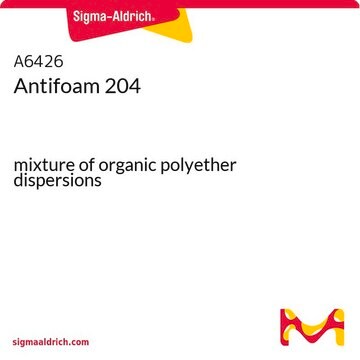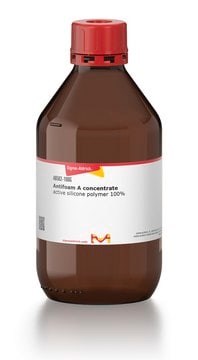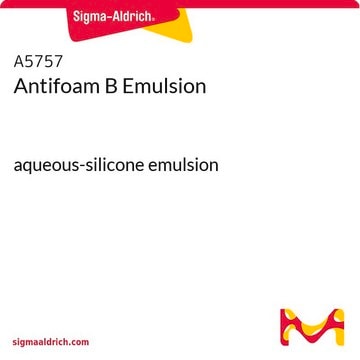A8311
Antiespumante 204
aqueous emulsion for bacterial and mammalian systems
Sinónimos:
organic antifoam
Seleccione un Tamaño
128,00 €
Seleccione un Tamaño
About This Item
128,00 €
Productos recomendados
Nivel de calidad
Formulario
emulsion (aqueous)
concentración
100% (organic)
densidad
1.01 g/mL at 25 °C
aplicaciones
microbiology
temp. de almacenamiento
room temp
idoneidad
(Mammalian (suspension))
bacteria (fermentation)
¿Está buscando productos similares? Visita Guía de comparación de productos
Categorías relacionadas
Descripción general
Aplicación
Antifoam 204 has been used:
- in the expression and purification of PUL (PLAP, Ufd3p, and Lub1p) domain[1]
- in fed-batch fermentation[2]
- to prevent bubble formation due in aeration in Luria Bertani (LB) culture medium for bacterial growth[3]
- in the batch fermentation with mineral medium[4]
Componentes
Otras notas
Nota de preparación
The optimal amount of antifoam required for various applications will need to be determined. Antifoam 204 is soluble in methanol, ethanol, toluene, xylene, perchloroethylene, and cold water at temperatures below 15 °C. It is insoluble in warm water and ethylene glycol.
Producto relacionado
Código de clase de almacenamiento
10 - Combustible liquids
Clase de riesgo para el agua (WGK)
WGK 3
Punto de inflamabilidad (°F)
Not applicable
Punto de inflamabilidad (°C)
Not applicable
Equipo de protección personal
Eyeshields, Gloves
Elija entre una de las versiones más recientes:
Certificados de análisis (COA)
¿No ve la versión correcta?
Si necesita una versión concreta, puede buscar un certificado específico por el número de lote.
¿Ya tiene este producto?
Encuentre la documentación para los productos que ha comprado recientemente en la Biblioteca de documentos.
Los clientes también vieron
Filtros activos
Nuestro equipo de científicos tiene experiencia en todas las áreas de investigación: Ciencias de la vida, Ciencia de los materiales, Síntesis química, Cromatografía, Analítica y muchas otras.
Póngase en contacto con el Servicio técnico










